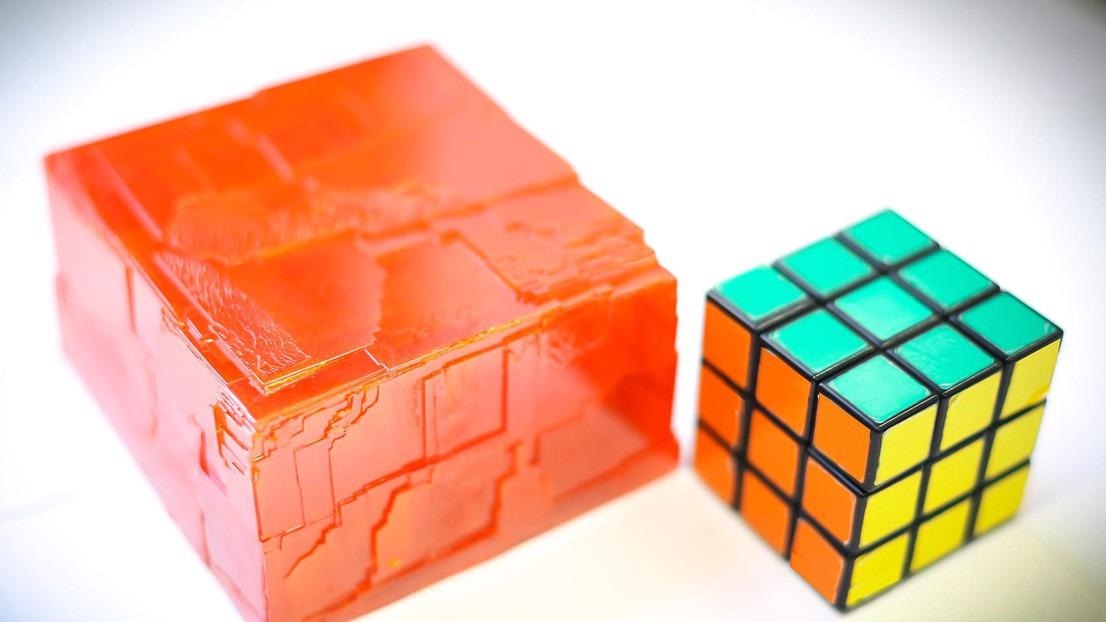Dec 10 2020
Perovskite materials are formed of organic compounds linked to a metal. These materials occupy the forefront of materials research due to their structure and properties and are suitable for an extensive array of applications, such as lasers, solar cells, photodetectors and LED lights.
 The 3.8 kg large CH3NH3PbBr3 crystal growth at LPMC for high-energy gamma-ray detection. The Rubik cube next sets the scale. Image Credit: László Forró (EPFL).
The 3.8 kg large CH3NH3PbBr3 crystal growth at LPMC for high-energy gamma-ray detection. The Rubik cube next sets the scale. Image Credit: László Forró (EPFL).
The photodetection—or light detection—application is of specific interest to researchers at EPFL’s School of Basic Sciences who have now created a perovskite with the ability to detect gamma rays. The researchers, headed by the labs of Professors László Forró and Andreas Pautz, have reported their study in the Advanced Science journal.
This photovoltaic perovskite crystal, grown in this kilogram size, is a game changer. You can slice it into wafers, like silicon, for optoelectronic applications, and, in this paper, we demonstrate its utility in gamma-ray detection.
László Forró, Professor, School of Basic Sciences, EPFL
Monitoring Gamma Rays
Gamma-rays are a type of penetrating electromagnetic radiation emitted from the radioactive decay of atomic nuclei, for example, in nuclear or supernovae explosions. Since they are at the shortest end of the electromagnetic spectrum, gamma-rays tend to have the highest energy and the highest frequency.
Thus, they can penetrate virtually any kind of material and find wide-ranging applications in industry, homeland security, environmental monitoring, astronomy, research, nuclear power plants and even medicine, to identify and monitor osteoporosis and tumors.
However, since gamma rays could damage biological tissue, it is essential to keep an eye on them. And this requires cheap, reliable, and simple gamma-ray detectors. The perovskite created by the EPFL researchers is based on methylammonium lead tribromide (MAPbBr3) crystals and appears to be a suitable candidate, fulfilling all these needs.
Crystal-Clear Advantages
Perovskites are initially 'grown' as crystals, and the clarity and quality of the crystals govern the efficiency of the material upon being formed into thin films that can be used in devices such as solar panels.
The perovskite crystals developed by the EPFL researchers exhibit high clarity with very low impurities. When the gamma-rays were tested on the crystals, they were found to produce photo-carriers with a high 'mobility-lifetime product'—a measurement of the quality of radiation detectors. Simply put, the new perovskite is efficient in detecting gamma rays at room temperatures, just through resistivity measurement.
Cheaper and Scalable Synthesis
The MAPbBr3 forms part of the 'metal halide' class of perovskites—that is, in contrast to market-leading crystals, it is possible to grow its crystals from low-cost and abundant raw materials. The synthesis occurs in solutions close to ambient temperature without the need for high-cost equipment.
This is certainly not the first perovskite developed for gamma ray-detection. However, the volume of a majority of the lab-grown metal halide perovskites used for this purpose is restricted to nearly 1.2 mL, which is very difficult to be scalable to commercial levels.
But the EPFL researchers also devised an exclusive technique known as 'oriented crystal-crystal intergrowth,' which enabled them to produce 1 L of crystals weighing 3.8 kg in total.
Personally, I enjoyed very much to work at the common frontiers of condensed matter physics, chemistry and reactor physics, and to see that this collaboration could lead to important application to our society.
Pavao Andričević, Study Lead Author, School of Basic Sciences, EPFL
This study was funded by the Swiss National Science Foundation and ERC advanced grant “PICOPROP.”
Journal Reference:
Andričević, P., et al. (2020) Kilogram‐Scale Crystallogenesis of Halide Perovskites for Gamma‐Rays Dose Rate Measurements. Advanced Science. doi.org/10.1002/advs.202001882.